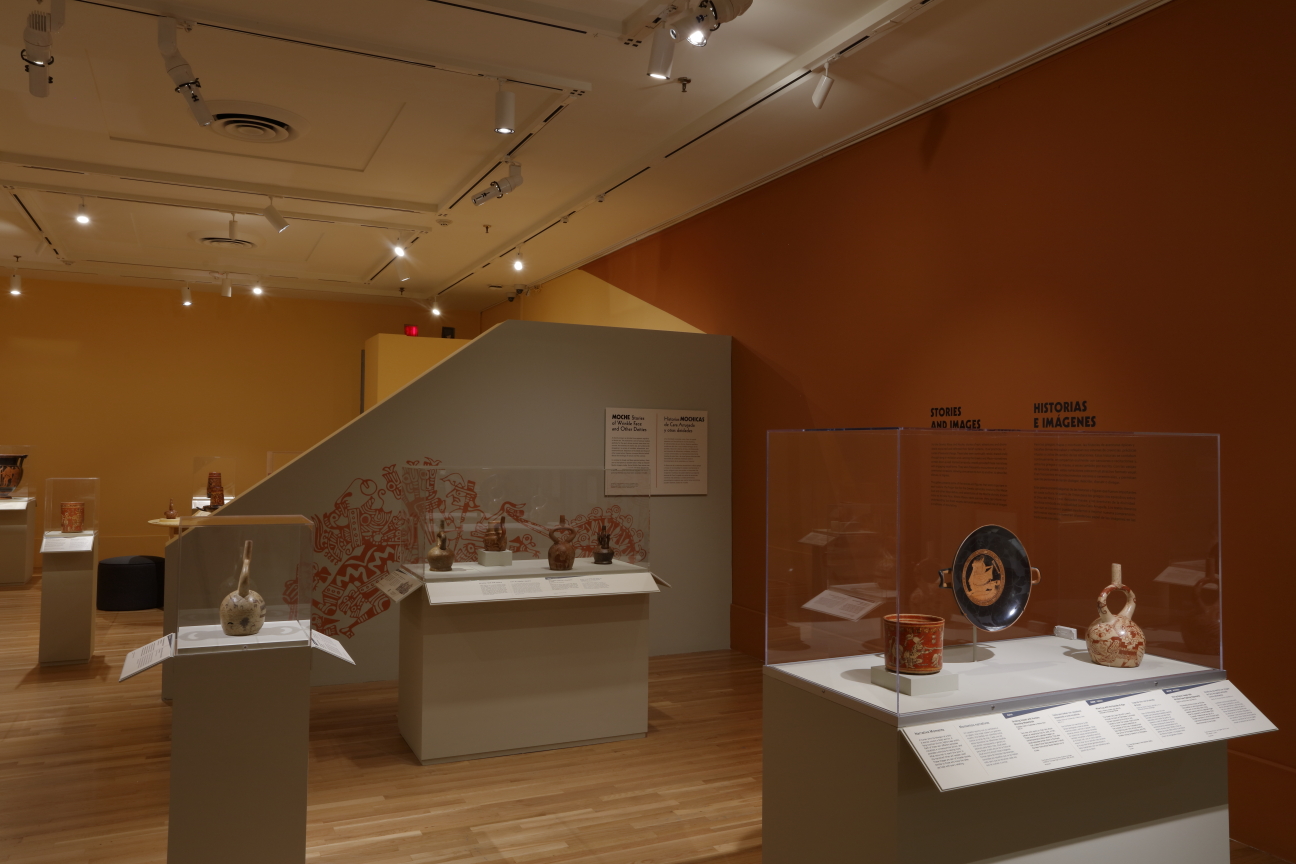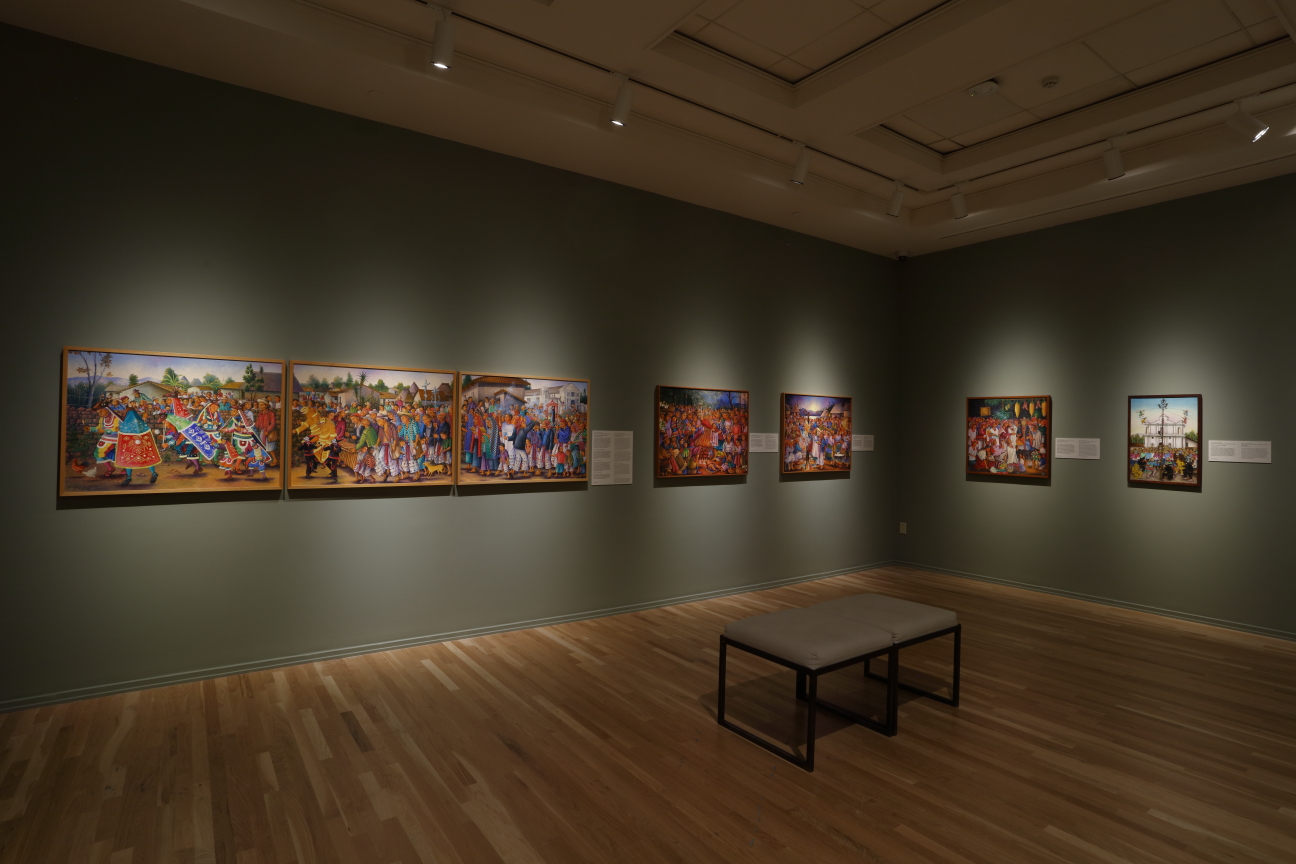Prepare to meet satyrs and sphinxes, violent legumes and a dancing maize deity.
Three distinct civilizations separated by space and time — Greek, Maya and Moche — come together as a master class in storytelling and social engagement in the exhibit “Picture Worlds,” on display at the Michael C. Carlos Museum through Dec. 15.
Each culture employed pottery as a way to tell stories, explain the world and illustrate core foundational narratives and beliefs, thus rendering every object in the exhibit its own “picture world.”
Curated by Megan O’ Neil, Emory associate professor of art history, and David Saunders, associate curator of antiquities at the J. Paul Getty Museum, the exhibit took shape over more than four years.
“It was a huge undertaking involving countries of origin for the objects, an international advisory group and multiple staff, and it would not have been possible without the resources of the Getty Museum and the energy of all who contributed,” says O’Neil.
“We are very pleased with this amazingly productive collaboration between Emory University and the Getty Museum,” says Henry Kim, associate vice provost and director of the Carlos. “It has succeeded in bringing together experts of different disciplines to reveal the similarities in approaches taken by cultures separated by time and geography. We are proud to support such original work.”
Drawing scholars together
The first stirrings of this groundbreaking cross-cultural exhibition arose when Saunders was a curatorial assistant in the European Paintings and Sculpture Department at the Los Angeles County Museum of Art (LACMA) in 2007. Through what he terms “an administrative oddity,” his desk was briefly in the Ancient Americas Department.
“I quite vividly recall that lightbulb moment of chatting with colleagues in that office and first learning about Maya and Moche painted pottery. As someone who had been studying Greek vase painting and pottery for a significant amount of time, for me to encounter these parallel narrative traditions on ceramics was profoundly eye-opening,” Saunders says.
In ensuing years of study and travel, Saunders let the idea of bringing scholars together to develop an exhibition project percolate. LACMA again proved fertile ground when Saunders visited O’Neil’s 2016 exhibit, “Revealing Creation: The Science and Art of Ancient Maya Ceramics,” and they struck up a conversation.
O’Neil had been immersed in Maya study since she was a Yale University junior learning from the legendary Michael Coe. His stimulating scholarship, combined with a contemporaneous visit to meet people of Maya descent in the Yucatan Peninsula, hooked O’Neil.
As she notes, “the conversation with David got both of us thinking: what more can you know by collaborating with specialists in other disciplines? And how do you establish a shared language for that project? Getting started with an idea this ambitious takes longer, but we were convinced of how much further we could go by putting our heads together.”

The three cultures at the exhibit’s center
“Many ancient Mediterranean cultures do not appear to have invested time and energy in producing complex narrative scenes on ceramics in the way that the Greeks did,” Saunders says. “It’s thus fascinating to encounter cultures with no trace of contact who happened on the same kinds of approaches and solutions.”
For the Greeks, decorating pottery with imagery reemerged as a practice around 800 BCE. The city of Athens was one of the primary producers, and around 600-400 BCE, Athenian black- and red-figure pottery was widely used in Greece and exported across the Mediterranean.
The Maya flourished in what is today southern Mexico and Central America for two millennia prior to the 16th-century arrival of Spanish invaders, who exacted a terrible toll on Maya health, economy and culture.
Maya pottery sometimes includes hieroglyphic writing denoting the intended owners and uses of the vessel. Nonetheless, O’Neil notes, “vessels may have a multiplicity of life histories — used by individuals, traded or gifted to other kingdoms, broken and tossed in trash middens or buried in offering caches and tombs.”
Moche culture arose in what is now northern Peru around 200 CE and endured until around 850 CE. All that is known of its people stems from their material culture and visual creations, for they did not have a writing system. An important use of Moche ceramics was to provide offerings to sacred beings in exchange for continued human flourishing.
Absorb the ancient stories and tell your own
Juxtaposing three complex and different cultures was the formidable task at hand for Saunders and O’Neil as curators.
“The exhibition offers a fresh way of seeing material that might be familiar, and we have conceived engaging ways of introducing material that might be unfamiliar. Through these three cultures, we are exploring bigger traditions of storytelling and image-making that continue to animate human activity. Not to mention all the amazing pots viewers will see,” says Saunders.
The exhibit was on view at the Getty Villa in Los Angeles from April 10-July 29, attracting an impressive 112,000 visitors during its run. At the Carlos, the exhibit is a bit different given each museum’s desire to maximize the use of its space.
O’Neil attended the Getty opening, which included a reception with members of the local Maya community. In a conversation with a young Maya man, he observed: “I didn’t know my own culture had such creativity.” Says O’Neil, “Knowing that this person is able to see himself and his ancestors in a new light makes all the work of mounting this exhibit worth it.”
Saunders and O’Neil share a curatorial philosophy prioritizing audience engagement.
“I don’t like quiet museums,” O’Neil notes. “Museums should not be places for disembodied looking but instead a way to get to know other cultures, places and artists as well as learning more about ourselves. We have added a new layer to that concept in the presentation at the Carlos.”
O’Neil was mindful that “we all have used ceramic objects to eat and drink.” For that reason, the first case that attendees will encounter shows “objects in use,” with examples from all three cultures. “We deliberately started with something familiar,” she says.
And just as the exhibition reveals how the artists told stories, attendees are encouraged to do the same in a space the curators created for live storytelling. That area also provides inspiration from an assortment of contemporary literature, including graphic novels, children’s books and more academic options.
At the conclusion of the exhibit, attendees have a rare opportunity to examine — and touch — replicas of three of the objects in the show. To create the replicas, the exhibition team turned to makers in some of the source countries.
“These are objects that were meant to be handled and manipulated. There is a fundamental tactile quality to them,” says Saunders. During the Getty exhibit, he recalls how enthusiastically attendees embraced this feature and how, despite the high visitor volume, the replicas survived with nary a scratch.
A Maya vessel in the show illustrates the further knowledge that handling can bring.
“It needs to be turned in opposing directions to fully tell its story. We think we know these ancient stories from linear narratives, but linearity proves to be a fiction. The artists sometimes are playing with our expectations,” O’Neil says.

Also on view: contemporary Maya art
A room of oil paintings by five contemporary Maya artists complements the Maya ceramics.
The paintings represent a contemporary art form developed by Maya artists in the 1930s but in many ways connect to the painted pottery, wall murals and books by earlier Maya artists. They, too, are “picture worlds,” narrating stories about spirituality, ceremonies, ancestors, health and government.
Welcoming students of all stripes
Saunders and O’Neil are the first to say that they remain students despite all they have learned from top scholars that led to the exhibition.
“For me, it has been about breaking down assumptions, seeing things differently and learning to be more uncertain, recognizing the limits of our knowledge and expertise,” Saunders reflects. “In writing the labels for this exhibition, Megan and I wanted to be open-ended, asking questions, acknowledging that there is a lot we don’t know.”
He recalls observing the last family moving through the Getty exhibit on its final afternoon, delighting in the replicas. “The mother, who was an educator, told me that ‘Picture Worlds’ had brought her to the museum for the first time. She then wanted to share it with her family, and indeed her son was using the exhibit for a class project. I was inspired all over again by what sharing art with one another can achieve.”
When O’Neil teaches, she assigns her students the essay “Museums as Contact Zones.” In her view, “The best contemporary exhibits don’t just impart knowledge; they ask people to share their knowledge. I am excited about the conversations this exhibit will stimulate.”
Additional ‘Picture Worlds’ programming
Highlights of events held in conjunction with “Picture Worlds” include a talk with Peruvian American artist Kukuli Velarde on Oct. 27; and the Lazlo-Excalibur Lecture with Nigel Spivey, senior lecturer in classical art and archaeology at the University of Cambridge, on Nov. 17. Consult the Carlos calendar for many more options associated with the exhibit.

